
![]()
Back in June of 2018, I was fortunate enough to make a 9-day trip to Yosemite National Park, California to capture the Milky Way galaxy over Half Dome. My entire trip revolved around capturing this image since I had captured nearly this same panorama two years prior during my first ever trip to the park in 2016.
It wasn’t until mid-2017 that I discovered that the panorama I had photographed in daylight in 2016 lined up perfectly with the Milky Way in May and early June. Immediately I knew that this pano was one that I would have to perfect, whatever I had to do in order to capture it with maximum detail.
Having improved my knowledge and technique for photographing the Milky Way and keeping clean foreground significantly since my 2016 trip, I knew that in order to keep the foreground free of noise I would have a few options.
- I could photograph the scene in roughly five images in vertical orientation as single exposures and stack five or more frames per section.
- I could blend the foreground from blue hour by photographing the foreground an hour after sunset using a little bit of atmospheric light to illuminate the foreground and then wait to photograph the Milky Way
- I could photograph the foreground as single exposures and stack them under starlight, then track the sky to preserve the maximum sky detail and blend them back together.
- Or finally I could photograph the foreground under starlight as long exposures at a higher aperture giving me more sharpness all the way through the image and use a low ISO to give me less noise. Then track the sky and blend them back together using a one image single exposure panorama beforehand with the alignment to use as reference.
After considering my options, I decided to go with the final method of capturing the foreground with longer exposures. This method would allow me to capture the foreground under natural starlight and maintain the natural colors and illumination of this time, and minimize the noise using a low ISO. This method also guaranteed I would have a sharp image throughout using a higher aperture and depth of field. I wanted to maximize the quality and resolution of this image to make it as large as possible for a potential future print.
Using the 45-megapixel Nikon D850 DSLR would give me an insanely large file that could be printed in large dimensions. The final panorama would be 27,500 pixels wide, and the final edit and crop was roughly a 350-megapixel image.
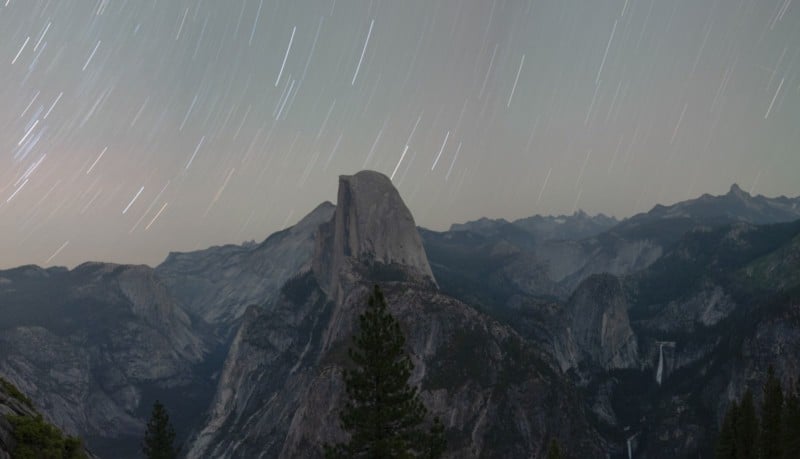
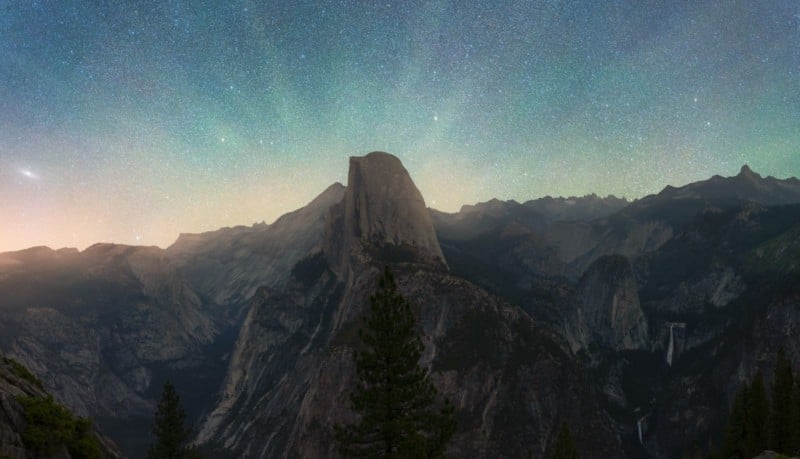
I would do this by setting my camera on my tripod in vertical orientation, making sure that my ball head was completely level, and waiting until I was under complete starlight.
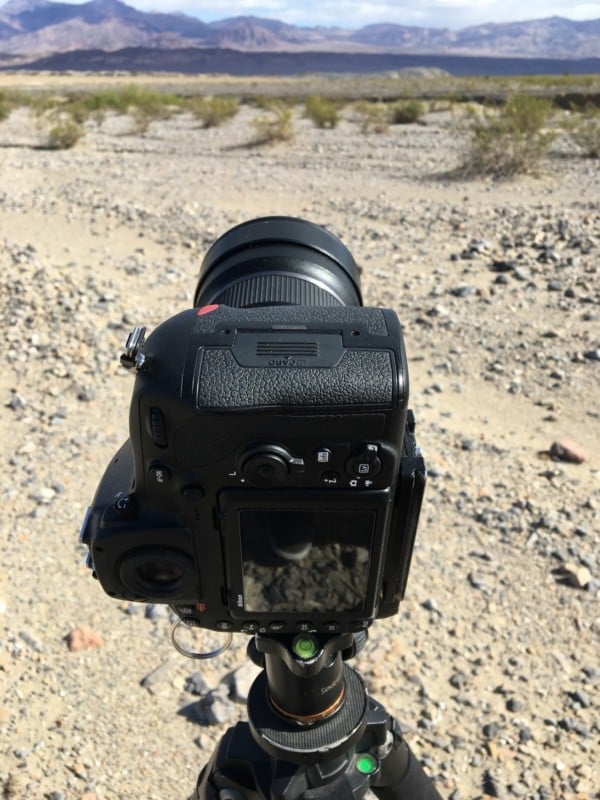
Having photographed the foreground panorama once before back in 2016, I knew that I would need 5 vertical images at 15mm to capture everything I needed, and having captured countless Milky Way panoramas, 4–5 images would give me a good view of our galaxy at 15 to 20mm.
In order to keep my exposures steady and keep my shutter open for long enough to capture all the light in a clean foreground image, I would need to use a shutter release remote so I wouldn’t bump the camera by pressing the shutter button. Using a remote would also allow me to program the exposure time for each frame.
Yosemite was a 1,000-mile trip one way for me from home (on the most boring stretch of road in the whole united states), so I planned my trip carefully ensuring I would be there during proper moon conditions, allowing me a window to photograph the sky without any moonlight.
Using the app PhotoPills, I carefully projected my alignment and opportunities to shoot the Milky Way while visiting the park. Once I had my plan together I started my preparations for a 9-day trip to make the most of my time there.
Doing a little experimental time lapse here from Olmsted point in Yosemite during my first night in the park. Having come from Nevada I found myself entering Yosemite from what I would call the back of the park and being able to see new parts of it I didn’t see in 2016.
Now if you are familiar with any of the stories of how I captured any of my previous images, you will know that coming prepared has never been one of my strengths. However, for a trip 1,000 miles from home and camping out in the desert alone, I made sure to create a rigorous checklist of things I would need. In an attempt to stay on a budget I decided to pack all the food and water I would need and blow up an air mattress in the back of my vehicle so I would be able to sleep periodically for short periods while photographing some kind of night sky image.
Included on this list of things was sunscreen, bug spray, and a shutter remote (of course). I ended up stopping for the first night of the trip roughly halfway to my destination somewhere in the Nevada desert, where I had an incredible dark sky to photograph. Already almost 500 miles from home, I discovered that though I had packed 4 shutter remotes and a whole pack of AAA batteries, I had left this insert for my pack somewhere at home, leaving me without any reasonable way of triggering my camera’s shutter remotely. Sadly the Nikon Snap bridge app would only allow me to program 30″ exposures.
Too far to turn back, I began photographing just 30″ tracked images to use for later images and dug through my gear for any kind of remote I might have from the past. Sadly I didn’t find any remotes, but I did happen to have a cool little device my father (an avid programmer and electronic project enthusiast) had made using an Arduino programmed to do various exposure types. Luckily for me, this device connected to any 1/8″ audio jack and I happened to have a spare cord for that. Also fortunate for me was the fact that the device had a bulb option.
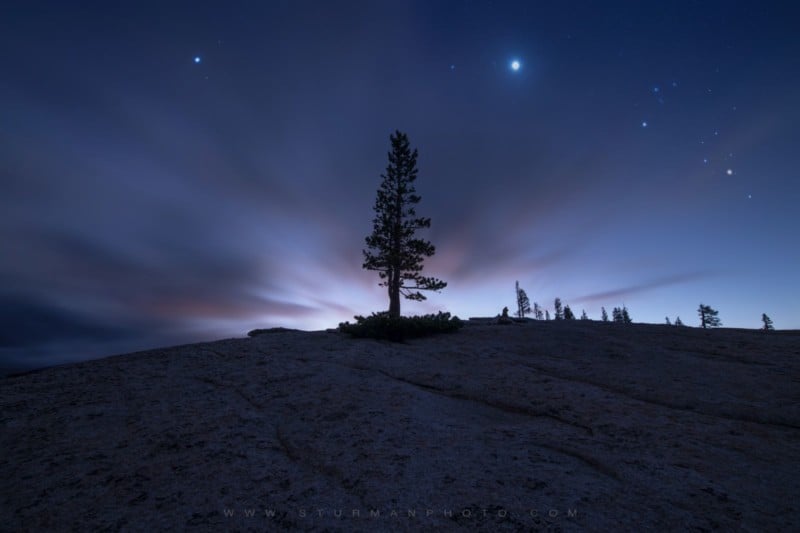
Once inside the park I was greeted by the unbearable summer heat, walls of mosquitoes so thick you could use them as shade, and of course unbelievable crowds of people. Despite all of this the park was spectacular and seeing it again was just as jaw-dropping the second time as the first. Absolutely nothing about this park is boring.
Having felt that I was prepared, I brought a bottle some kind of all-in-one sunscreen bug repellent spray. Immediately upon visiting the park I needed both, as the early summer heat and pooling water in the valley attracted millions of mosquitoes and the heat was almost unbearable in direct sunlight.
My first night in the park I broke out in some kind of terrible rash. Something I had not experienced since I was very young. Hives covering my arms, neck, and body made for a very uncomfortable stay. Thinking I had some kind of mosquito bite that had initiated the rash, I began applying more of this bug spray sunscreen mix. The cause of my terrible full body rash was sadly unknown to me. So from day one I was a little irritable and had a hard time standing the conditions of the trip. Also unfortunate to my trip itinerary, I planned to stay a full 7 days and saw no need to buy new sunscreen or bug spray and assumed it was anything from some kind of plants in the area to something I was eating.
I had planned to do all my shooting in new locations and scouting first and save my Milky Way panorama over half dome from Glacier Point until the last two nights of my stay so I would force myself to endure the entire trip knowing I would not allow myself to give in a go home until I had completed that image. Reserving my final two nights, since the image would likely take several hours of shooting just to complete the pano for the foreground and several hours of shooting just for the sky.
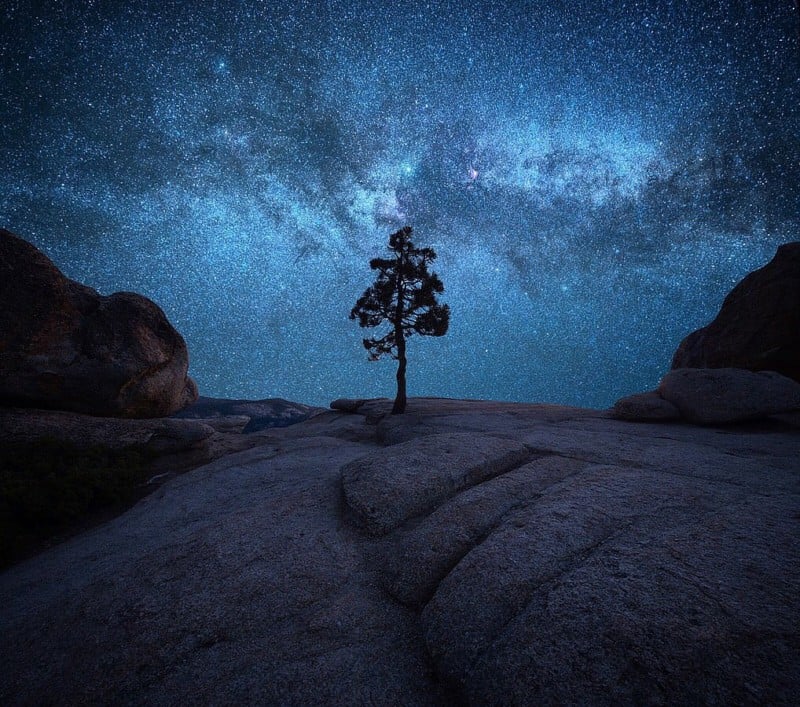
When the time came to capture my panorama I went to Glacier point almost 6 hours early just to get a parking spot. The lot at the top of the road for the popular overlook is often heavily crowded and has very few actual parking stalls. When I arrived there weren’t any so I ended up driving in circles for about two hours waiting on an opportunity to park. Once I parked, I quickly began packing my gear to go watch the sunset and set up for my image.
In my excitement and hurry to finally get out to the spot and quickly dying sunlight, I managed to lock my keys inside my car. Having done this multiple times in the past I have a habit of checking for keys as I am walking away from my vehicle and realized I had locked them inside. I spent the next two to three hours trying to find a way to get into the car. I had no service in that area so I would have to hitch a ride with someone all the way down to where I would get service to call AAA. I actually went and found a sick and managed to pry the passenger side door open just a little and tried to slip thin sticks in and flip the lock switch. After seeing the apparent damage I was doing to the seal on the door I went to back pop out windows.
I noticed that these windows had a small latch that could be pressed out so that the windows could angle outwards but no open all the way. I figured if I could break this small plastic latch I could crawl in through this window and unlock the car. But after prying just a little too hard, I shattered the window and glass went all over me and the parking lot.
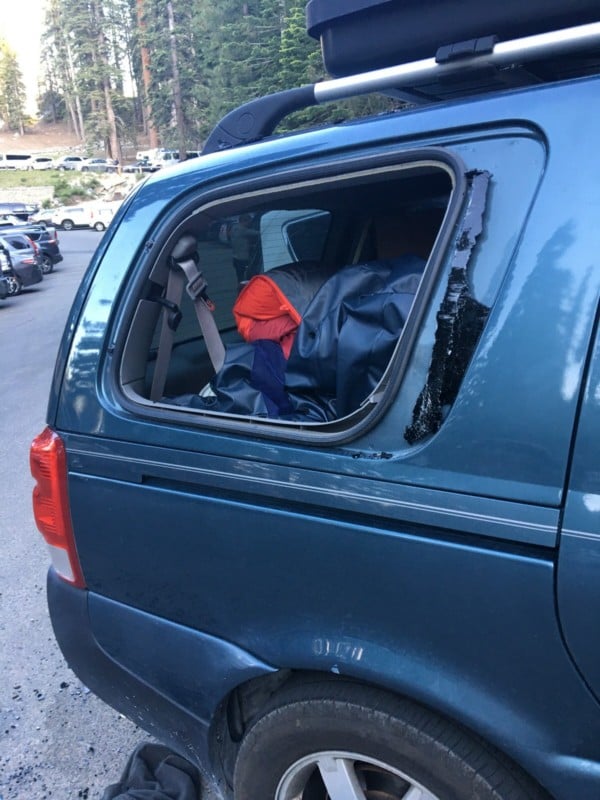
Needless to say, I missed the sunset. And once I was inside my car and covered in glass, I wasn’t in the most inspired mood, but after cleaning up the glass in the parking area as best I could, I moved out to my spot for the image.
I began by focusing on the foreground, and realized that once I had my camera set up in the proper position, the Arduino remote’s programmed bulb mode required me to hold the button down for the duration of the exposure. There was no programmable time setting in its programming, meaning I would need to sit and hold the button down until the exposure was done.
I’m not going to lie: it’s fortunate that only my good friend the Milky Way was there to hear what I said next. Interestingly enough, yelling to a large beautiful vista is actually quite therapeutic, but I was quickly distracted by the beauty of the Milky Way rising over the Yosemite Valley.
Glacier point provides one of the most amazing views of Yosemite. Looking head on half dome, you can see an insanely large vista. Waterfalls, peaks, and large cliff faces into forested valley’s. The scale of this place is simply indescribable.
Once the Milky Way started to appear I took a quick test exposure, f/2.8 ISO 12,800 30″ and focused on a bright star to make sure I was getting infinity focus throughout. In my f/28 image, it looked like most of the image was sharp so I decided just to increase my aperture slightly. I started out by trying an image at f/5 but after holding down the button for so long and seeing I made a mistake I decided to stop back down to f/3.2. Once the test exposure was complete I used Photopills exposure calculator to calculate the images exposure time needed if I were to use f/3.2 at ISO 800. I figured this would give me a clean foreground image without me losing too much time to each exposure before sunrise.
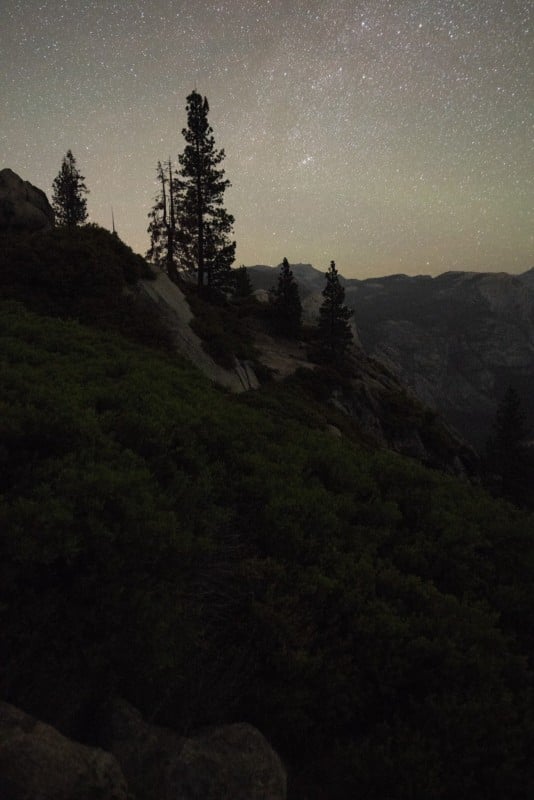
This gave me an exposure time of roughly 13 minutes per frame. So I set a thirteen-minute count down timer in Photopills and sat with my finger on the button until the alarm went off.
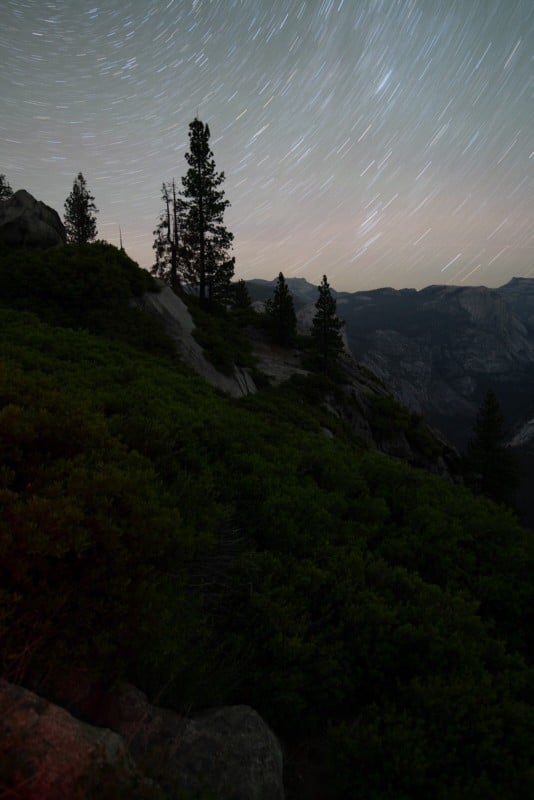
Unfortunately for me, I didn’t realize that the red light from the homemade remote was casting onto the rocks in front of me, so I photographed this first exposure a second time.
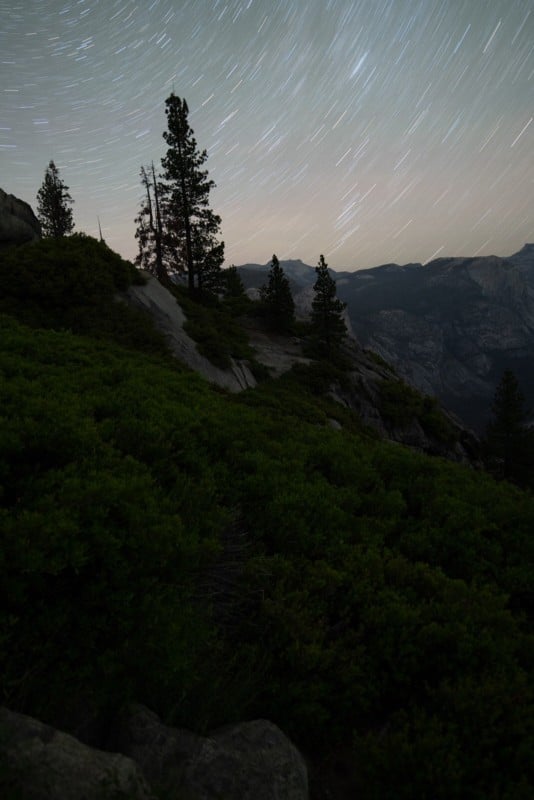
Unfortunately, I had bumped my tripod or ball head somehow without noticing and the image had tilted slightly. Tired and irritated, I battled with the idea of using this image but ended up deciding to realign and try again.
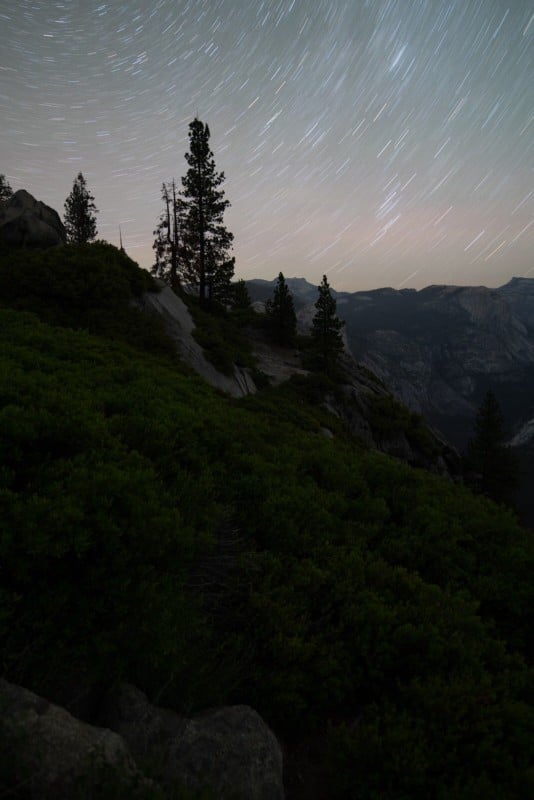
I finally had the first of five images correct. I carefully reviewed the image for noise and detail at 300% zoom.
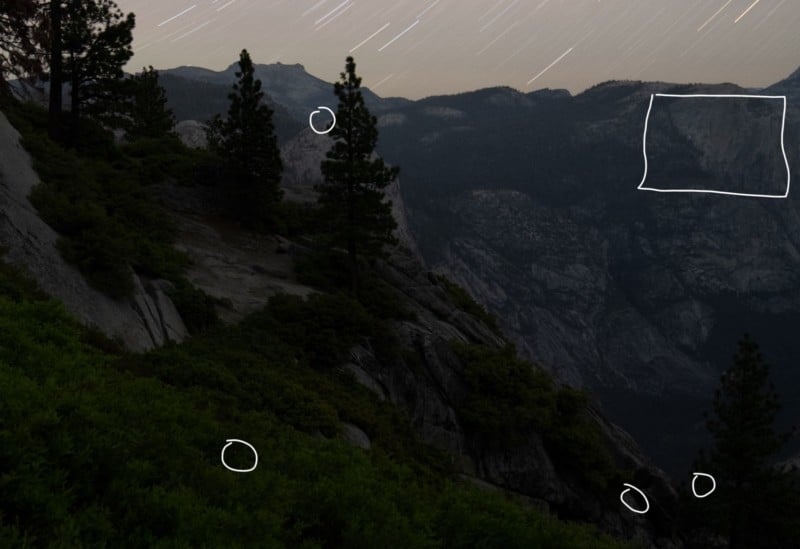
Aside from a few hot pixels from the long exposure and warm weather, and a little noise on the surface of the peaks the image looked sharp and mostly clean.
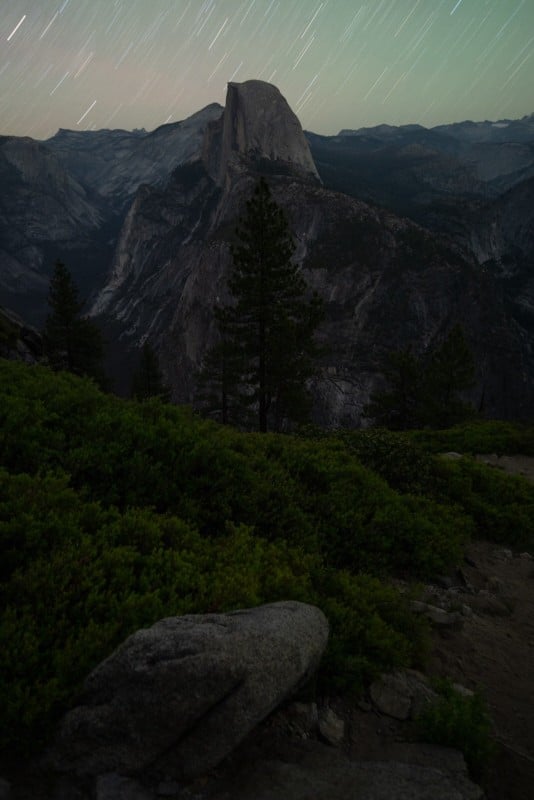
The following two images went smooth, though my thumb was getting a little tired from holding down the button to keep the shutter open. That was until the fourth image.
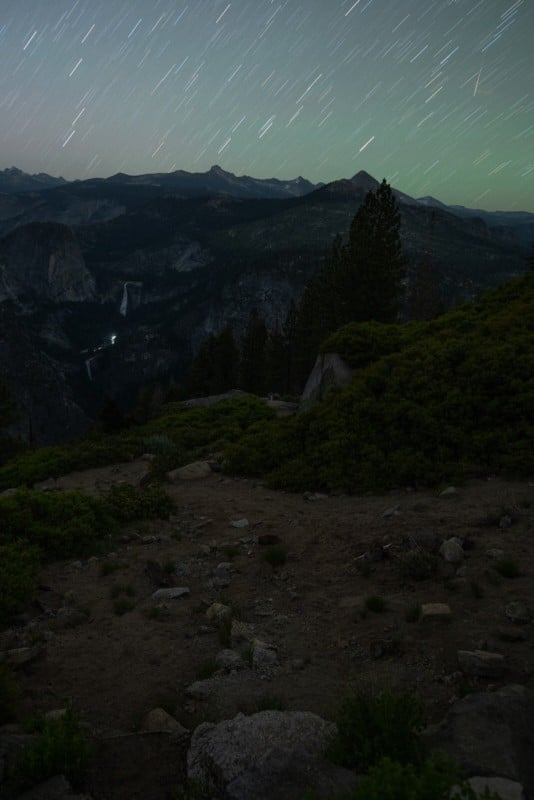
I stopped this exposure early when I noticed some hikers with flashlights creating some trailing. This could have easily been cloned out in post but I didn’t want to risk it so I started over.
Finally, after a few more images I had the complete foreground merge. Due to technical problems, bumping my tripod during a couple and starting over, It was astronomical twilight shortly after completing the final image in the pano.
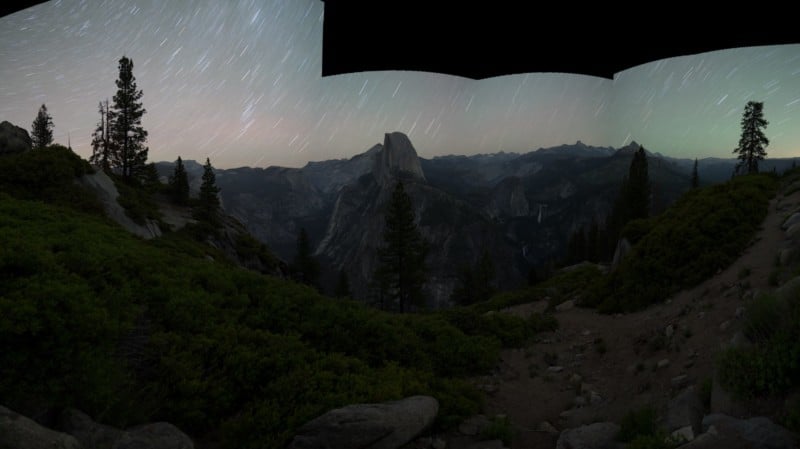
Once all the images had been stitched and the distortion corrected and image compositionally balanced this was the foreground result. Now all that was left was to photograph the sky! I returned the following night to set up my tracker from the location where I shot this pano, however using a tracker requires a clear view of Polaris, the northern star, to calibrate the tracking. Sadly I was unable to see Polaris from this location due to all the tree cover.
I began searching for nearby locations with absolutely clear horizons and discovered Taft point, an overlook just back down the glacier point road. This seemed like the closest sure-fire location with clear skies.
I quickly hiked out to the location during sunset and promptly set up my tracker to capture my sky panorama.
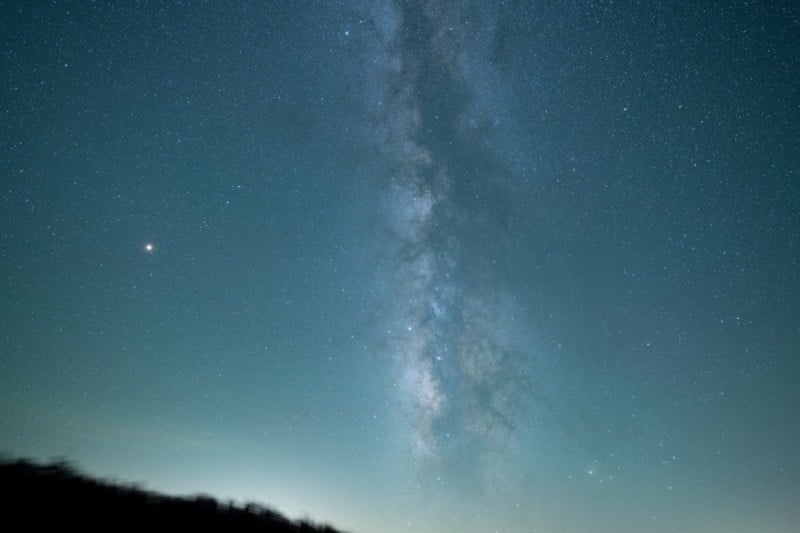
One of the single images tracked from Taft Point.
Taking several attempts to get the sky right and clean with as little foreground as possible I had my sky after shooting all night.
And once twilight hit I was so ready to be done with shower less, rash-ridden, mosquito-infested forests that I packed up and hiked straight to the car to start the long journey home. My image was finally captured and it was time to get back to the desktop and start putting the pieces together.
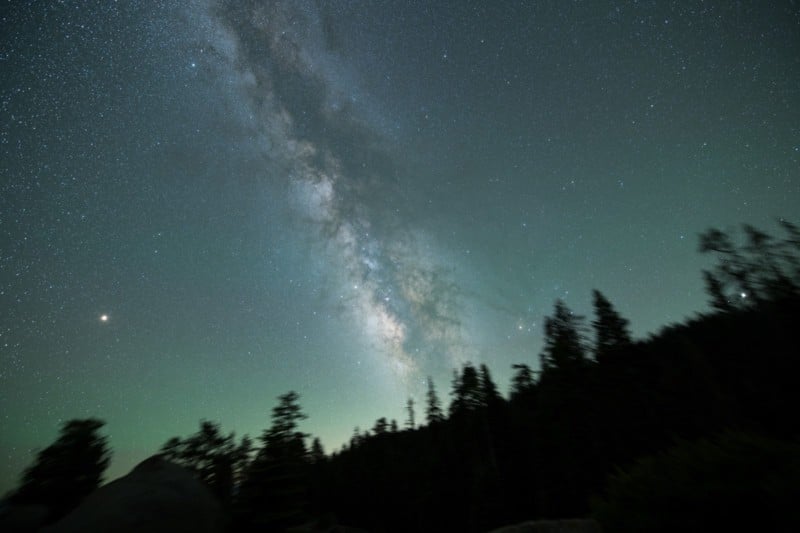
And with that my 9 day trip to the incredible Yosemite came to end, and after a long and boring drive through the deserts of Nevada, I would be able to review my images to see how I did.
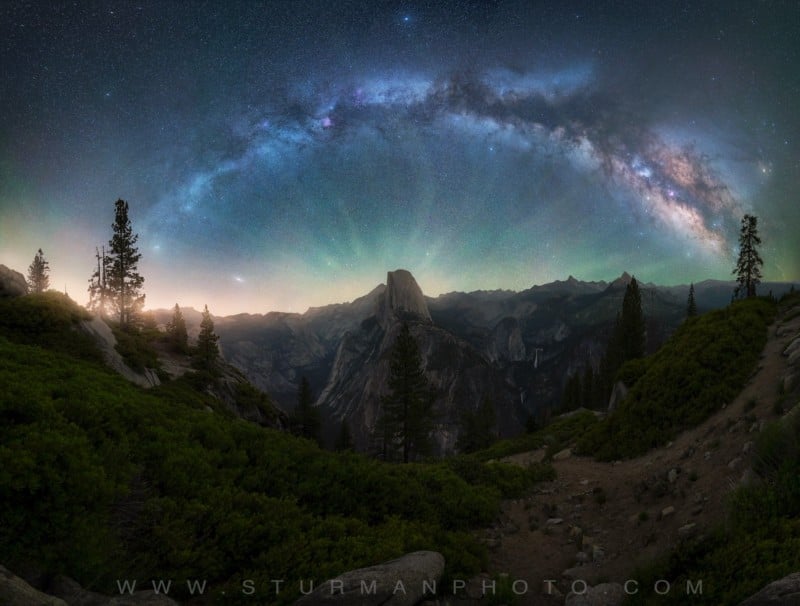
Thanks for reading! I hope something in this was beneficial to you, or maybe at least you won’t make some of the mistakes I have and never buy all-in-one bug spray and sunscreen…
P.S. If you’d like to learn more about photographing the Milky Way you can check out some of my one-on-one and group workshops hosted across the western United States on the techniques and tricks I use personally. Or if you would like to know how I post process my images, consider checking out my paid post processing Instructional courses for Adobe Photoshop.
About the author: Derek Sturman is a landscape and night photographer. The opinions expressed in this article are solely those of the author. You can find more of Sturman’s work on his website and Instagram. This article was also published here.

